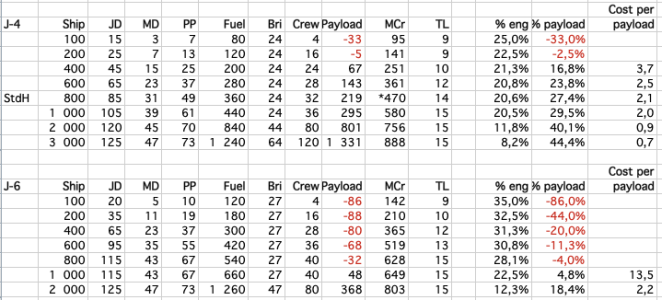So let me give you an example of how EXPENSIVE "good computer models" can get in a small craft ... specifically a 30 ton form factor.
Fighter Provincial (Type-FP, TL=9)
30 ton small craft hull, configuration: 1 (MCr3.6)
0 tons for Armor: 0 (TL=9)
5 tons for LBB2.81 standard A/A drives (codes: 6/6, TL=9 civilian, EP=2) (Agility=6 requires EP: 1.8) (MCr12)
1.8 tons for fuel (19d 12h 50m endurance @ 1.8 EP output continuous)
6 tons for bridge (crew: 2) (pilot, gunner) (MCr0.15)
2 tons for model/2 computer (TL=7, EP: 0) (MCr9)
1 ton for triple turret: missile, missile, missile (TL=9, codes: 1/1/1, EP: 0, 3 missiles per battery, 12 reloads) (MCr3.35)
4 tons for 2 single occupancy small craft staterooms (MCr0.1)
* External Docking: 170 tons capacity (MCr0.34)
10.2 tons for cargo hold
- 0.1 tons for 15 person/weeks consumable life support reserves (2 crew=7.5 weeks endurance)
- 0.1 tons for 10 ton capacity collapsible fuel tank (MCr0.005)
= 0+5+1.8+6+2+1+4+10.2 = 30 tons
= 3.6+0+12+0.15+9+3.35+0.1+0.34+0.005 = MCr28.545
- 1G = 200 - 30 = 170 tons external load
- 2G = 100 - 30 = 70 tons external load
- 3G = 66 - 30 = 36 tons external load
- 4G = 50 - 30 = 20 tons external load
- 5G = 40 - 30 = 10 tons external load
- 6G = 33 - 30 = 3 tons external load
Fighter Provincial (Type-FP, TL=9)
30 ton small craft hull, configuration: 1 (MCr3.6)
0 tons for Armor: 0 (TL=9)
5.1 tons for LBB5.80 Maneuver-6 (Agility=6 requires 1.8 EP) (MCr2.55)
8.4 tons for LBB5.80 Power Plant-9 (EP=2.8) (MCr25.2)
1.4 tons for fuel (9d 20h 22m endurance @ 2.8 EP output continuous)
6 tons for bridge (crew: 2) (pilot, gunner) (MCr0.15)
3 tons for model/3 computer (TL=9, EP: 1) (MCr18)
1 ton for triple turret: missile, missile, missile (TL=9, codes: 1/1/1, EP: 0, 3 missiles per battery, 12 reloads) (MCr3.35)
4 tons for 2 single occupancy small craft staterooms (MCr0.1)
* External Docking: 225 tons capacity (MCr0.45)
1.1 tons for cargo hold
- 0.09 tons for 13.5 person/weeks consumable life support reserves (2 crew=6.75 weeks endurance)
- 0.01 tons for 1 ton capacity collapsible fuel tank (MCr0.0005)
= 0+5.1+8.4+1.4+6+3+1+4+1.1 = 30 tons
= 3.6+0+2.55+25.2+0.15+18+3.35+0.1+0.45+0.0005 = MCr53.4005
- 1G = 255 - 30 = 225 tons external load
- 2G = 102 - 30 = 72 tons external load
- 3G = 63 - 30 = 33 tons external load
- 4G = 46 - 30 = 16 tons external load
- 5G = 36 - 30 = 6 tons external load
- 6G = 30 - 30 = 0 tons external load
In other words, just a +1 EP and +1 computer model buff ... increased the construction cost by 53.4005/28.545 =
+87% ...

Now, obviously ... @ TL=13-14 (and of course, TL=15) that calculus changes, because power plants get smaller (and cheaper!) per EP they produce. However, the computer models available also ramp up dramatically (model/7 @ TL=13), thereby making small craft fighters "uneconomical" in terms of cost per turret.
Which means ... that the "cheaper" way to higher protection levels with low tech small craft is NOT to be found in the engineering design specs, but rather in the crew skills!

Pilot-3 skill means +1 Agility.
Ship Tactics-3 means +1 computer model (offense and defense!).
In other words, at low tech levels (9-11) you want cheap fighters and skilled pilots to win your battles for you.

40 years * 13 months = 520 crew salary payment cycles
53.4005 - 28.545 = MCr24.8555 / 520 =
Cr47,799 per month in increased construction cost amortized over 40 years (average)
Pilot skills tend to increase salaries by
Cr600 per month per +1 skill level.
Given that kind of "return on investment" ... I know that as a military budget controller I would rather be spending credits on personnel than on constructing more expensive fighters ...

Not exactly something that the Traveller chargen "preaches" (or makes readily available) ... but definitely a way of thinking about the optimal mix of outcomes.




